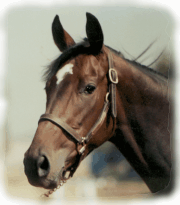|

|
A
Horse, Of Course
by Don Blazer |
He's
a wale of a horse, because he's not a Whale of a horse, just a
Waler.
A Waler is the national horse of Australia and derives his name
from his region of origin, New South Wales. He is also known as
the Australian Stock Horse.
Similar to the American Quarter Horse, he has an alert, intelligent
look, with a full eye, wide nostril and broad forehead. He has
a long, graceful neck, set well on a sloping shoulder. He has
a deep, wide chest, well-sprung ribs, well-developed forearm,
short, flat cannon bone and strong, powerful hindquarters, well-muscled
and nicely rounded.
The first horses were imported to Australia in 1795 and they had
their foundation in Dutch and Spanish blood, as well as, Arab
and Barb ancestors.
From these first horses came type selection-some were used as
saddle horses, some as cavalry horses, and some as racing horses.
(Racing was established in Australia in 1826.)
The Waler, which comes in a variety of conformation types, gained
international fame during World War I when the heaviest type forged
a legend for courage and stamina in handling bulky artillery.
His contribution to the war effort earned him a place as one of
the most famous horses within the British Empire.
While the Waler may be the actual original Australian Stock Horse,
today's Australian Stock Horse horse is more compact and well
balanced. The early Waler showed a lot of ranginess from the Thoroughbred
and a lot of bulkiness from the draft breeds.
The Australian Stock Horse was bred for work on a station (ranch),
capable of working in rough terrain and capable of handling cattle
and sheep.
The Australian Stock Horse Society was formed in 1971 with the
aim of preserving the identity of the horse and promoting breeding
and performance. As with most American breeds, I suspect the society
was actually formed with financial gain in mind, which is okay,
but not as lofty as the written purpose. As with the American
Quarter Horse, the first to be registered had to be inspected
and approved by "classifiers."
Change is the only constant, even in Australia. It wasn't too
many years ago that an Australian Stock Horse was expected to
push cattle or sheep down the road, then go to the local horse
show and compete in as many as six or seven different events.
At the end of the day he may even be rushed home to stand at stud.
Today the stock horse may still work cattle in the morning, but
at show time he is only going to be expected to do his "specialty",
whatever that may be.
The most popular "specialty" today may be the cutting
horse. Australians love cutting horses and have every right to
brag about them. (Aussies aren't shy about bragging on a horse.)
There aren't as many cutting horse trainers in Australia as there
are in the U.S., but percentage wise, I think they may better.
The Australians are darn good horsemen, and they still do more
actual work with cattle on horseback than we do.
When a horse works cattle all day, not under show conditions,
cutting at a competition can be a piece of cake. For the most
part, American cutting horses don't get the opportunity to just
ride the range, relax and then cut for a reason. Practice, practice,
practice just isn't quite like "living the life."
From what I've seen, virtually any Australian riding a cutting
horse could compete and win in the United States. A lot of U.S.
riders would take a beating in Australia.
But as good as they are, if you ask them, every Aussie cowboy
will tell you he still dreams of living the life of the American
cowboy-the good life!
***************************************************************
Visit www.donblazer.com
for information endorsed by the horse.
.







